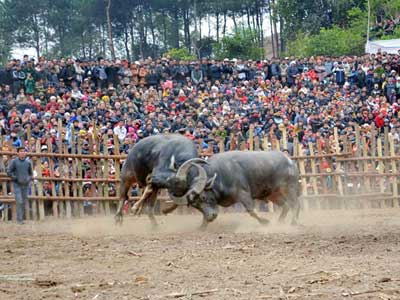Do Son Buffalo Fighting Festival: A Manifestation of a Nation's Pride

Every 9th day of the eighth month of the Vietnamese lunar calendar, the people of Do Son District, Haiphong City celebrate an annual tradition called Buffalo Fighting Festival to honor their Water God and Hien Sinh custom. But aside from its religious aspect, the festivity is also a time for the local people to show their bravery and love for their culture.
It takes about one year to plan and prepare for the festival. From the selection of buffaloes, ceremonial preparations, entertainment plans and other details, everything is done carefully and grandiosely. A buffalo must have specific qualities to be eligible to join in the contest. It must be between four to five years old; have a good physical appearance; wide-chested; big-groined; long-necked; long-tailed; sharp-bottomed; toned thighs; bow-shaped horns; well-fed; and trained. They are fed in their own cages to separate them from the “common” ones.
Like most celebrations in Vietnam, the Buffalo Fighting Festival consists of the ceremonial rites and the entertainment. In the spiritual ceremony held on the first day of the eighth lunar month, a sacrificial rite is made to honor the town's Water Goddess. Led by the elders, holy water is passed on to the villages which have buffalo entries. The ceremony starts at the General Commune House of all villages in Do Son and ends at Diem Tuoc God. Six animals which are properly cleaned are to be part of the ceremony accompanied by their owners. The buffaloes are then covered with red cloths and tied with red bands on their horns to bestow on them the title “Sir Buffalo” which encompasses the local people's spiritual life, hope and belief. Early morning on the ninth day of the eighth lunar month, the people meet at the hall and begin a loud and colorful mass procession to send the buffaloes to the fighting arena.
The entertainment part of the festival is made up of traditional activities such as flag dancing wherein 24 young and strong men wave and dance along to drums and cymbals played loudly. This is done on the ninth day of the eighth lunar month and have to be especially boisterous in a belief that the loud sound will hype up the buffaloes and make them more combative. The actual buffalo fighting follows wherein two of the anointed animals are brought into the arena to begin the highlight of the whole festival. Standing on opposite sides at first, the buffaloes gradually move closer to each other after each signal, finally commencing to fight after the ropes attached to their noses are taken off, to the excitement of the crowd.
At the end of the fight, the winning buffalo will be killed as an offering to the Water Goddess in exchange for good fortune, security, safe journeys, rich harvest and good health for the whole year. The other buffaloes will also be sacrificed to ask the Heaven and Earth for wealth and happiness. The animals' meat is believed to bring good luck when eaten.
Originating since the 18th century, Buffalo Fighting Festival at Do Son will continue to be practiced in the future since it stands on a solid ground of faith and courage of a people truly proud of its culture.









